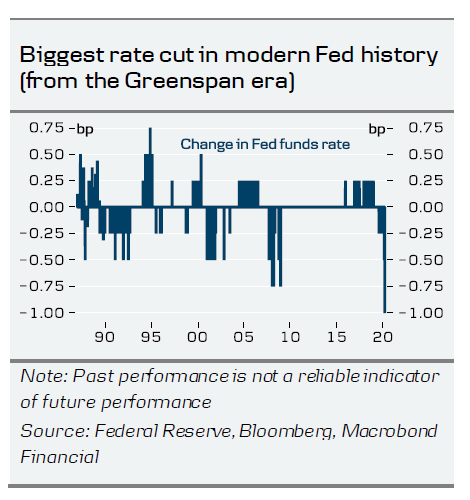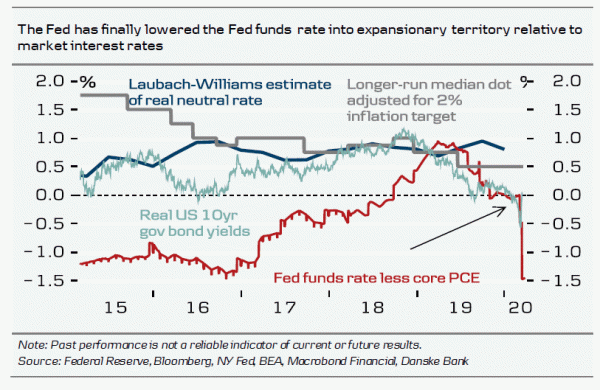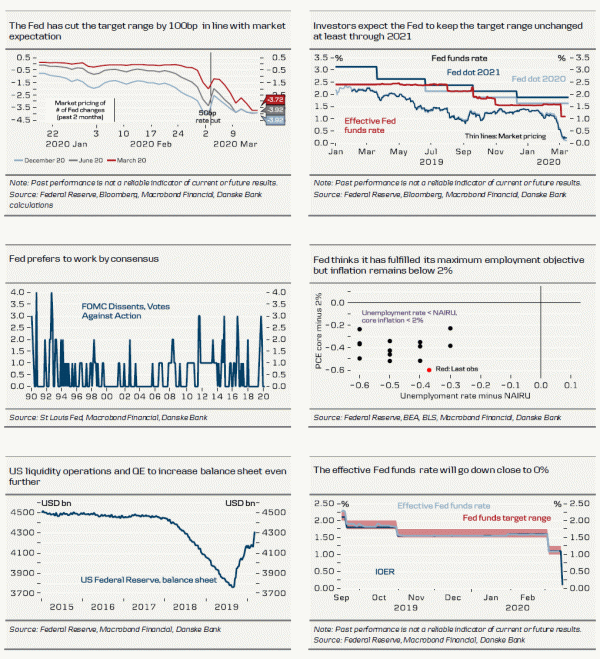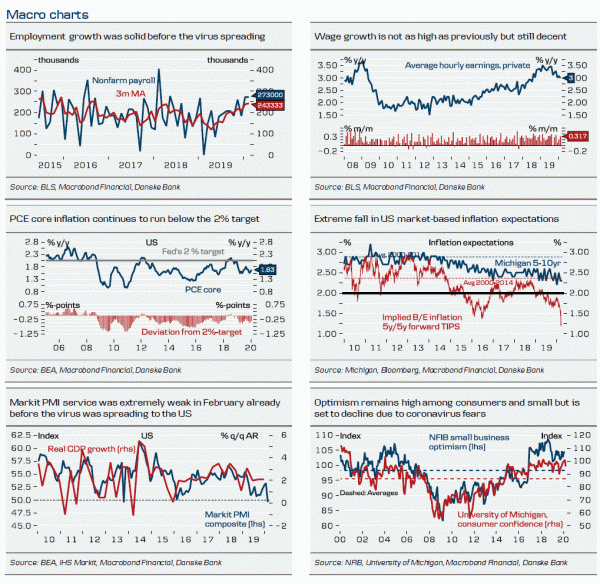The Fed just went all in on fighting against the coronavirus and its impact on the economy and markets, see FOMC statement, leaving only last-resort options left (see page 2). We think this is very positive, as economic research shows that fast and forceful response makes monetary policy more potent. Still, the big rate cut in particular and probably also to a large extent the QE programme were already priced in, which may help explaining why US stock futures are dropping in early trading. They rose more than 9pct on Friday. If the Fed had not come big this week (either now or Wednesday), we would probably have seen a major sell-off. Also, investors are still concerned about the negative development on the coronavirus. The new announcements comes on the top of the recent 50bp emergency rate cut and the increased injection of liquidity into the system.
- The Fed has cut its target range by 100bp to 0.00-0.25%, which is the first time in modern times (the Fed did not even cut by 100bp during the financial crisis)
- The Fed strengthened its forward guidance stating that it expects “to maintain this target range until it is confident that the economy has weathered recent events and is on track to achieve its maximum employment and price stability goals”.
- The Fed has restarted QE and will over the coming months buy USD500bn worth of US Treasuries and USD200bn worth of mortgage-backed securities (MBS). It will also reinvest all principal payments. This should push long-dated yields lower. Especially, the important MBS rates should stabilise due to the QE programme.
- The Fed has lowered its primary credit rate by 150bp to 0.25% (i.e. 50bp more than the target range) and encourage depository institutions to turn to the discount window to help meet demands for credit from households and businesses. At the same time, the Fed has announced, depository institutions may borrow from the discount window for up to 90 days. See also statement.
- The Fed encourages depository institutions to utilize intraday credit extended by Reserve Banks. See also statement.
- The Fed encourages banks to use their capital and liquidity buffers, as they lend to the private sector. The Fed argues that the buffers are designed to support the economy exactly in situation like this. See also statement.
- The Fed has reduced reserve requirement ratios to 0% (effective on 26 March). See also statement.
- In a coordinated move with the Bank of Canada, the Bank of England, the Bank of Japan, the European Central Bank and the Swiss National Bank, the Fed has announced “coordinated action to enhance the provision of liquidity via the standing US dollar liquidity swap line arrangements”, see statement. The price has been lowered by 25bp such that the new rate is OIS plus 25bp. Foreign central banks will now start offering US dollars with a 84-day maturity in addition to the current 1-week maturity operations already in place. This should lower the fears of losing access to US dollars.
It is difficult to see what more the Federal Reserve can do in the short-run although they have some (last resort) options. The Fed could begin yield-curve control like Bank of Japan, an idea in particular Brainard is fond of.
- The policy rate is still positive and could be lowered into negative territory , which, however, most FOMC members are not keen on. Powell restated this during the press conference after the cut.
- The Fed can eventually also lend directly to companies like it did during the Great Depression and the Great Recession under Section 13(3).
- The US Congress could also change the Federal Reserve Act allowing the Fed to buy a broader range of financial assets, including stocks and corporate bonds, an idea proposed recently by Eric Rosengren. The Fed is at the moment limited to buy government-backed bonds like mortgage-bond securities and US Treasuries.
The US senate is set to approve the second emergency spending package next week and it seems likely that a third is on its way. In that way, the US is finally responding both from the monetary and fiscal side to the current situation, which has moved in the wrong direction.
Ahead of the announcement of Fed’s easing p ackage and the coordinated G6 USD liquidity action last night, EUR/USD was under pressure from all sides: rising sovereign risk premia, Fed rate inaction, and stricter virus containment across Europe. But, then the key ‘surprise’ risk of a Fed cut materialised, and EUR/US D jumped a rough big figure on impact. The big question now is whether this will be enough to ease the credit/funding stress that EUR/USD has begun to trade (i.e. depreciate) on last week? It may alleviate the USD funding issues near term, but after the ECB re-opened the sovereign-risk factor for EUR last week, the EUR leg may still prove a drag on the cross – not least if the call upon EU fiscal policy is overheard by politicians.
















